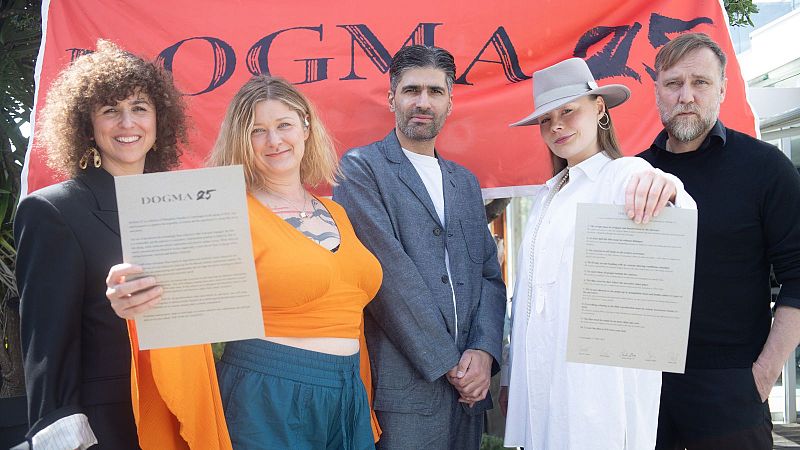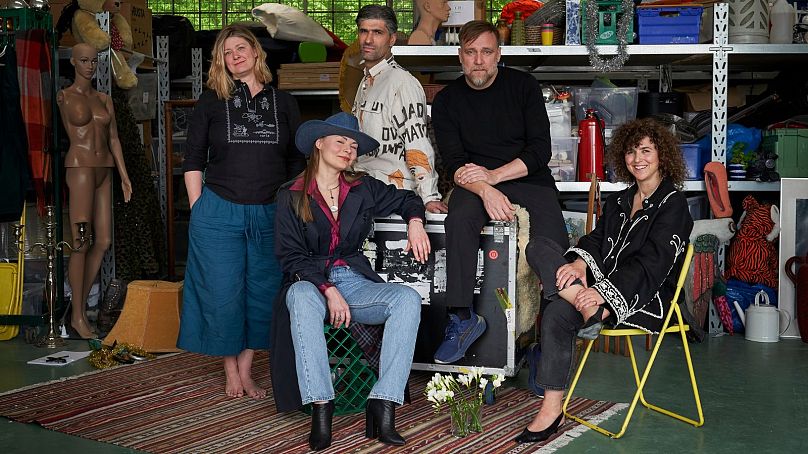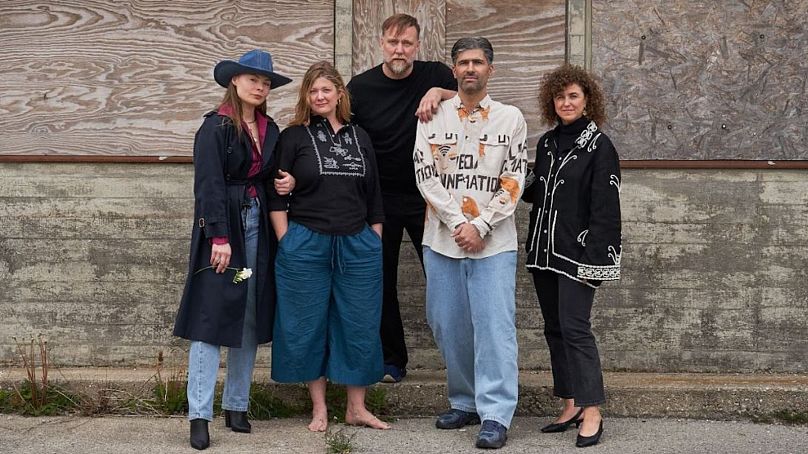
30 years after the original cinematic movement, a group of Danish and Swedish filmmakers have relaunched the avant garde Dogma 95, with a new manifesto that has been updated for the internet age.
“In a world where film is based on algorithms and artificial visual expressions are gaining traction, it’s our mission to stand up for the flawed, distinct and human imprint,” said May el-Toukhy, Milad Alami, Annika Berg and Isabella Eklöf and Jesper Just in a statement read at the Cannes Film Festival.
“We champion the uncompromising and unpredictable, and we fight against the forces working to reduce cinematic art to an ultra-processed consumer product.”
Described in its manifesto as “a rescue mission and a cultural uprising”, Dogma 25 has been endorsed by the two best-known directors to emerge from the original Dogma movement: Thomas Vinterberg and Lars von Trier – as well as von Trier’s production company Zentropa.
Both filmmakers said in a statement: “In ’95, we made films in the certainty of peace. And created a revolt against conformity. In ’25, new dogmas are created, now in a world of war and uncertainty. We wish you the best of luck on your march toward reconquering Danish film.”

For those who need a refresher, Dogma 95 was a manifesto unveiled by von Trier and Vinterberg, which highlighted a set of rules aimed at creating films based on the traditional values of story, acting and theme, while excluding the use of special effects.
Both filmmakers wanted to establish a new extreme, saying: “In a business of extremely high budgets, we figured we should balance the dynamic as much as possible."
The manifesto, which mimicked Truffaut’s "Une certaine tendance du cinema" – the Cahiers du Cinéma article which kickstarted the French New Wave in 1954 - compiled a “Vow of Chastity”. These were the terms that would determine whether or not a film could be considered part of the Dogma 95 movement.
The 10 rules were:
- Shooting must be performed on location, without providing props or sets that don't logically exist within that setting
- Diegetic sound only. Sounds must never be produced, such as music that does not exist within the scene
- All shots must be handheld. Movement, immobility and stability must be attained by hand
- The film must be in colour, with no special lighting. If there's not enough exposure, a single lamp may be attached to the camera
- There can be no optical work or lens filters
- No 'superficial' action (such as staged murders, elaborate stunts etc.)
- Temporal and geographical alienation is strictly forbidden, meaning the film must take place here and now
- No genre movies
- Academy 35mm is the only accepted film format
- Directors must not be credited
Dogma 95 would develop into a collection of 35 films, but the best known are 1998’s Festen and The Idiots – two hugely influential films for contemporary European cinema.
In 2002, it was generally accepted that Dogma 95 had ended, especially following the statement made by Vinterberg: “It was always meant to be a wave, and they don't go on forever."

The Dogma 25 manifesto contains 10 new dogmas. The filmmakers said they have taken a “new vow of chastity” to uphold the rules, which they explained are influenced by three central themes: a return to the physical reality, aesthetic restrain, and economic and geographic accountability.
The new manifesto only retains one of the original’s self-imposed rules (read on to see which one) and most challenging of the new rules is that Dogma 25 films must be made “in no more than a year”, and the use of the internet “is off limits in all creative processes”.
Here is the full new manifesto:
DOGMA 25 is a collective of filmmakers founded in Copenhagen in the spring of 2025. Our stated purpose is to preserve the originality of cinema and the opportunity to create film on its own terms.
The role of the director has increasingly been reduced to that of project manager, the film to a commodity, and the audience to consumers. Experimental practice is stifled by fear of risk-taking, which suffocates artistic exploration and silences unique voices. When films are merely executed and not allowed to evolve organically, it puts the art form in danger of becoming functional, obedient and thereby irrelevant.
In a world where formulaic films based on algorithms and artificial visual expression are gaining traction, it’s our mission to stand up for the flawed, distinct, and human imprint. We champion the uncompromising and unpredictable and we fight the forces working to reduce cinematic art to an ultra-processed consumer good.
By scaling down production, we ensure that everyone on the team has an intimate relationship with the film and its message. This will enhance mutual trust and a sense of collective responsibility for the film and for each other. It also allows us to safeguard the flexibility that is vital in making a creative process dynamic and intuitive, rather than purely executive.
We celebrate DOGMA 95, all the filmmakers who came before us, and those who will come after. We stand together to defend artistic freedom as a shield against pointlessness and powerlessness. DOGMA 25 is a rescue mission and a cultural uprising.
To protect and preserve what we hold dear, we hereby submit to the unflinching and unbreakable set of rules called: THE VOW OF CHASTITY.
THE VOW OF CHASTITY: I vow to submit to the following set of rules drawn up and confirmed by DOGMA 25:
1. The script must be original and handwritten by the director. We compel ourselves to write the script by hand in order to nurture the kind of intuition that flows most freely from the dream, channelled through the hand onto the paper.
2. At least half the film must be without dialogue. We insist on a cinematic approach to filmmaking, because we believe in visual storytelling and have faith in the audience.
3. The internet is off limits in all creative processes. We commit to produce the films relying on real people within our physical reality – rather than in a digital one infused with algorithms.
4. We’ll only accept funding with no content altering conditions attached. We assume responsibility for keeping budgets down so the team retains final say in all artistic decisions.
5. No more than 10 people behind the camera. We commit to working in close collaborations to build trust and strengthen our shared vision.
6. The film must be shot where the narrative takes place. Film as an art form becomes artificial and generic when we portray a location in a false light.
7. We’re not allowed to use make-up or manipulate faces and bodies unless it’s part of the narrative. Just as we strive to maintain the authenticity of the location, we also want to portray the human body without a filter. We celebrate it – warts and all.
8. Everything relating to the film’s production must be rented, borrowed, found, or used. We commit to making films using objects that already exist and renounce the ahistorical and self-destructive culture of consumerism.
9. The film must be made in no more than one year. We abstain from any lengthy processes that stand in the way of creative flow.
10. Create the film as if it were your last.

The new initiative has been met with excitement, with Tine Fischer, the Director of The Danish Film Institute, saying: “Any system, even one that runs impeccably, needs examining. Needs challenging. Needs to cast a courageous look on itself. Throughout the last decades, Danish film has distinguished itself internationally with myriads of Academy and Cannes nominations and a unique position in our own market. We are known globally as a strong nation for film, and Danes here at home love Danish film. But no success has a lifetime guarantee.”
She continued: “30 years ago, DOGMA 95 turned the eyes of the world toward Denmark and left a radical imprint on our national self image as a filmmaking nation. The people were few, the number of films limited, but the impact was huge. We need these brave artistic visions now more than ever. Visions befitting a new time – which is exactly what the new DOGMA 25 represents: A strong group of noticeably different filmmakers, who have collectively committed to artistic radicalism. How do we make films, how do we ensure our freedom of expression in a distinctly challenged geopolitical world, and how do we safeguard the singularity of art.”
She added: “As a film institute, we are facing a time where our cultural contributions are tasked with ensuring state of the art Danish films – now and in the future. It’s not a simple task, but deep inside the task lies the ability, as a system, to make space for film as a free art form, for innovation and perspectives. This is why we are especially happy and proud to support DOGMA 25 in their early stage, both with concept development and the international launch in Cannes.”







